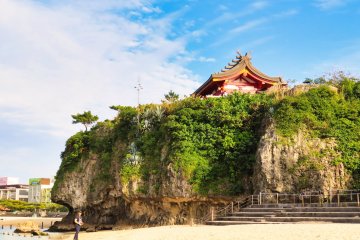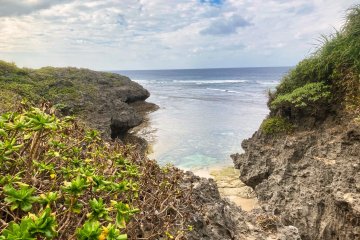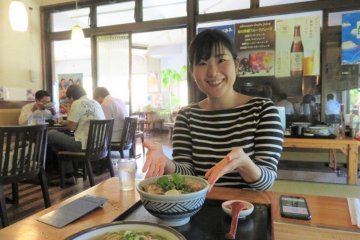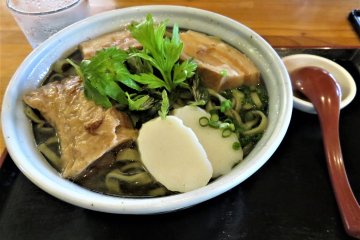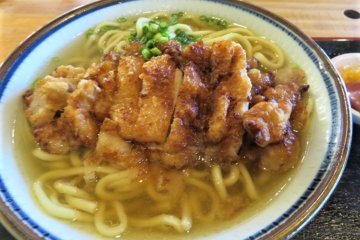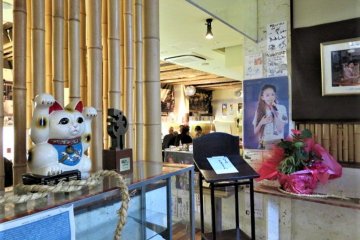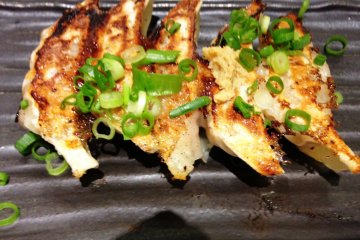The other day, I had some beef brisket at the izakaya. It was tasty and tender, and what’s more, reminded me of the offal skewers I had when I was at school, half the world away. The type you can find on the night markets. The power of taste is so evocative in bringing back a long-lost memory.
In Okinawa, a dish that reminded me of my childhood is Tebichi, boiled pork leg that is eaten Oden style in a soup. While not offal, its slow-cooked deliciousness is so evocative. It is a dish that is not well known in other parts of Japan but having lunch with the specialists from the Okinawa Convention and Visitors Bureau is like opening the door to the secrets of Okinawan cuisine, beyond the signature dishes like Okinawa Soba.
Okinawa Soba – What is it
Okinawa soba is the signature soul food of these islands. Unlike the grey buckwheat noodles in mainland Japan, the soba here is made with wheat, giving it a slightly chewy texture similar to Udon but is flatter, making it easy for the whole family to eat.
In this part of the world, Okinawa Soba has been accredited as part of the longevity diet. The collagen in the pork helps the skin to remain supple and healthy, even in old age. What’s more, it is delicious, with a rich slightly sweet flavour and a sinuous texture, when paired with the broth seasoned with dashi stock, and topped with slices of fish cake, chopped green onion, and red pickled ginger. There isn’t a lot of pork in the soba bowl, just enough for seasoning. It is part of the philosophy of hara hachi bun me, which is to be satisfied when you are 80% filled and to enjoy food without overeating. It is such an iconic dish that you can learn how to make it from scratch in a cooking class, such as a Taste of Okinawa.

A Tropical Odyssey
Nahatei also features the Kobara Manzoku Lunch set, with soba, small appetizers, and your choice of drive and dessert.
They also serve freshly squeezed tropical juices, such as Dragon Fruit and Citrus Depressa. The latter is also known in English as Shiikuwasha, Shequasar, Okinawa lime, or Hirami Lemon, which is a small, green citrus fruit rich in flavonoids and native to the Okinawan Archipelago. It is perfect for a humid summer day.
Okinawa has cultivated sugarcane since the 14th century, so why not experience their creativity with their local brown sugar, with a salty complexity drawn from the rich mineral soils. You can choose between the Mango Pudding, Annin Tofu, Okinawa Cold Zenzai made with Adzuki beans, or the Pineapple cake with whipped cream, a popular sweet around the Pacific. "You eat it, you'll get sick." Maybe someone is trying to steal my portion.
The Queen and her entourage
Nahatei’s location between the airport and the city is convenient for arrivals and departures alike. With 200 seats, there is plenty of room for a visiting Queen and her entourage or a school group on a karate convention. There is also ample parking for buses. The private Jasmine rooms are suitable for groups of 10 to 100 people between 10:30 am to 9:30 pm all year round. While I was there during a busy lunchtime, it did not feel rushed or overly crowded, quiet enough to enjoy my meal and conversation.
All things noodles
Imagine being able to island-hop to savor noodle styles, starting here in Okinawa, and ending in Honshu Island. In Kyoto, try Ippudo for ramen, Omen for Udon. In Tokyo, try Tsuta Ramen.






